#Hedendom
Note
Hi, this might be a stupid question but are paganism and heathenry interchangeable?
No such thing as a stupid question! The short answer is no, not exactly.
Paganism can refer to a number of non-indigenous spiritualities. It often includes paths like Wicca, Hellenism (Greek), Religio Romano (Roman), various flavors of "Celtic" polytheism (Irish polytheism, Gaelic polytheism, etc), potentially Kemeticism (Egyptian), and others.
Heathenry refers to certain kinds of cultural ideas and observances that originate from specific places in Northern Europe. It typically comes in Norse, Slavic, or Germanic flavors.
Heathenry is pagan in nature, but there's ongoing discussion on whether it should be lumped under "Neo-Paganism", or if "Norse Paganism" and "Norse Heathenry" are the same or different at all. But that's a whole different discuss I don't need to confuse you with.
(Fun fact, in Swedish—if not all the Scandic languages—"heathenry" and "paganism" are actually the same word, "hedendom." So they're interchangeable in that context!)
117 notes
·
View notes
Text
"Piskarna" uppenbarade sig i Ryssland under 1600-talet - under de första Romanovernas styre. [...] Denna godtrogna blandning av hedendom och ortodoxi kunde inte uppstå annat än i det primitiva, skoningslöst förtryckta, livegna Ryssland. Piskarnas lära öppnade inför den undergivna bonden en värld av oändliga möjligheter, ty den sade: varje man kan bli en "kristus", varje kvinna en "gudsmoder". Det gällde bara att fördriva köttets syndfullhet, att med ett rättskaffens leverne och böner förbereda själen till att den heliga Ande bosatte sig i den - fostra Kristus i sig själv, bli till honom. Att den helige Ande bosatte sig konkret i människosjälarna var en mystisk bokstavstro som de obildade bönderna med glädje accepterade. Varje piskarförsamling [...] hade sin "kristus" och sin gudsmoder".
Edvard Radzinskij, Rasputin : Rysslands svarte eminens
0 notes
Text



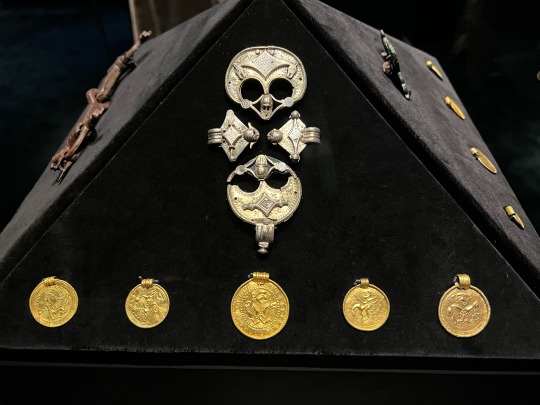
Kulturhistorisk museum in Oslo hosted an exhibit named “Fabulous Animals”, exploring the connection between humans and animals in the period from the Iron Age to the Viking Age, through archaeological finds.



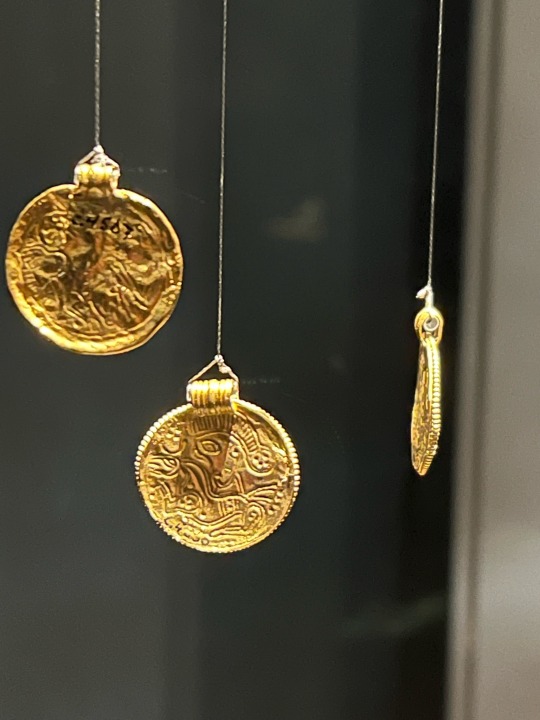


I hope you will enjoy some photographs of some of the exhibits.
Til års og fred
#asatru#norse mythology#heathen#pagan#norse heathen#forn sed#vikings#viking#norse pagan#forn sidr#nordisk sed#norse#åsatro#forn siðr#hedendom#odin#ásatrú#norse gods
208 notes
·
View notes
Text
I was asked in response to my earlier post about my focus on Þórr, in this case vs Óðinn but I imagine it can apply to most any comparison.
It's partially based on history and partially based on personal experiences. Starting with history, Þórr was very much popular amongst the general population, and in a lot of ways it seems that while the political and military elite favored Óðinn for obvious reasons, outside of that it was Þórr (and Freyr) who tended to occupy the high spot in worship. In Adam of Bremen's description of the Temple of Uppsala, it's Þórr whose statue occupies the central and most prominent position with Óðinn and Freyr flanking him.
Using theonymic place names (I don't remember if that's the totally correct term) to help fill in the gaps, Þórr also seems to be widely popular in terms of places named after him while Óðinn is more popular in certain areas, especially in Denmark iirc, but that kinda makes sense as well since the martial aspect of the culture was more prominent and a lot of power consolidation was occurring there. Same with spots in Norway. Meanwhile, Iceland has a total or near total absence of place names containing Óðinn as an element, but they were also more conservative and resistant to the sort of power consolidation that was going on in the mainland areas, and remained more democratic. This also lends credence to Óðinn's increased popularity amongst nobility and military elite.
Beyond that, runic inscriptions such as ᚦᚢᚱ᛫ᚢᛁᚴᛁ (Þórr vigi, Thor bless/protect) in a number of places and his function as a consecrator, hallower, etc suggest that he was pretty well regarded as a protector and guardian figure. Terry Gunnell's Pantheon? What Pantheon? article also shows how he may have been worshiped as a sort of all-purpose god. It also suggests that the average person may have only really had one or a small handful of gods whom they normally worshiped, and that worship of a larger pantheon or family of gods was likely reserved for major gatherings where people from a variety of backgrounds were in attendance, such as the blót at Uppsala described by Adam of Bremen.
On a personal level, I simply feel a lot closer to Þórr than I ever really have to Óðinn. My hobbies and interests, while sometimes venturing into Óðinn's territory such as poetry, galdr, etc.; tend to be more in line with what feels like Þórr's area such as smithing (I feel no connection at all to Völundr), brewing, etc. Plus he's always had more of a "highly respected friend" feel to him, at least to me personally. I don't really know that I'd call my self a henotheist, there are a couple of other deities with whom I feel a closeness and to whom I do give offerings and prayers on occasion, but I'm not far off from it. At least for major deities; I do give offerings to my house and land spirits as well, but that's on a separate level.
And this isn't to say that I straight up don't like Óðinn or that I feel it stupid or incorrect to worship him (although I won't say that he isn't often a dick); absolutely not. It's just not what I've come to feel is really right for me. But that's also kind of the beauty here. While there are certain things that are pretty solidly central and important to Old Norse religion or religious systems, there's no real mandate on whom one has to worship, and as more research is done there's more evidence suggesting that this sort of variety was more commonplace historically than has previously been thought.
Okay, I can kinda see why Tumblr was cutting me off there.
54 notes
·
View notes
Note
Hello my friend. Might I pick your brain if you do not mind? I have read several theories regarding stanza 24 of Lokasenna when Loke says of Odin: “draptu á vétt sem vǫlor” “You struck/beat on vétt like a sorceress” In your own opinion, do you consider it likely that vétt refers to a drum
Sorry for taking long to respond, I wanted to make sure I had time to read this paper by Clive Tolley in its entirety: https://www.academia.edu/26659214/The_hunting_of_the_v%C3%A9tt_in_search_of_the_Old_Norse_shamanic_drum
I highly recommend this paper for anyone interested in the subject, and I find myself in agreement with Tolley that definitive conclusions are impossible but that we can balance probabilities. It seems to me that, of all the speculations, the most likely (or perhaps, least unlikely) is that the vétt was a term for an object that in some ways resembled a drum but which was otherwise used primarily for some other mundane purpose, especially one which was expected to be performed by a woman.
For anyone who doesn’t click through (I recommend at least skimming it, it is a very dense paper but organized well), Tolley describes and compares a Scottish folk tradition of using the wecht, a winnowing drum, an implement for separating grain from chaff. Importantly, winnowing drums have in fact been used as drums to make music (see: riddle drum), but folk traditions that incorporate them into divination do not make use of them as musical instruments, and based on the examples cited in the article are pertinent especially to young women.
I got an ask a few weeks ago about drumming in Old Norse culture which I still haven’t responded to, because there is surprisingly little evidence for it in general and I have had little material to create a response from. They do have some terminology for drums which suggests familiarity with it, but most sources that refer to drums or drumming are translations and/or are set in distant places. Exceptions to this, like one mention in Göngu-Hrólfs saga, are written very late, and is mentioned specifically to magnify the opulence of the affair in which they appear along with many explicitly foreign objects.
I do think it’s possible that the word refers specifically to a Sámi drum, and I think it’s more likely that, in that case, the foreignness of the object is an important part of Loki’s characterization of Óðinn in this stanza. One reason I hold out this possibility is that I have found no mention of Sámi drums in all the instances of bumba or trumba, the normal Norse words for drums. While it’s reasonable to believe that Norse authors might not have mentioned Sámi drums, it seems impossible to me that they would have been unaware of their existence. However, I do not think that the use of the word in the poem is evidence that Norse people had their own tradition of using drums for ritual purposes like the Sámi.
I hope this rather noncommittal answer is helpful.
38 notes
·
View notes
Quote
*record scratch* *freeze frame* Yup, that's me. You're probably wondering how I ended up in this situation.
Þórr, arriving to marry ��rymr, probably.
139 notes
·
View notes
Photo

Valkyrie amulet.
#norse mythology#valkyrie#odin#asatru#heathenry#pagan#norse#norsepagan#asatro#hedendom#forn sed#Titibaka
593 notes
·
View notes
Photo
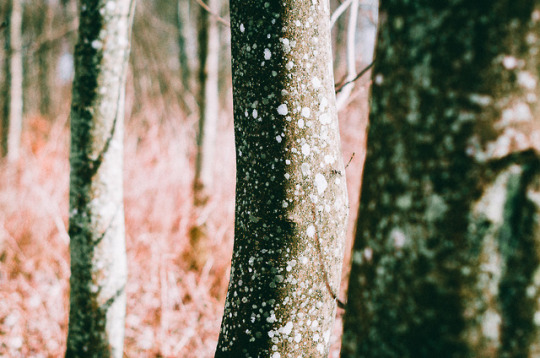

Somewhere in Denmark, April 2018 | Jægerspris, Sjælland | No wolves in these wannabe woods. Denmark now has an officially registered movement called “Wolf-free Denmark”. We live in sad, sad times where there’s less and less space for wilderness -- both in our shrinking forests and in people’s minds. Does human hubris and egoism know any limit?
#treesaremygods#treesarebeautiful#photographers on tumblr#original photographers#nature photographers#landscape photographers#wild nature#denmark#scandinavia#nordic nature#pagan#animism#hedendom#sense of place#nature#forestmood#forest#woods#outdoors#plant rebellion
21 notes
·
View notes
Text
Mari - Europas sista hedningar
Mari - Europas sista hedningar Vi tittar på en film om det finsk-ugriska folket Mari och hur de försöker bevara sin hedniska identitet
Vid folkvandringstidens början var stora delar av dagens Ryssland befolkat av finsk-ugriska folk. Under folkvandringstiden började slaviska folk expandera österut från dagens Polen. De Finno-Ugriska folken pressades då norrut och österut, utom Ungrarna som hamnade “bakom” expansionen och flyttade västerut.
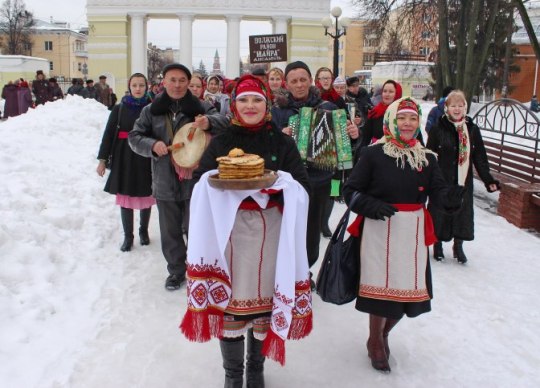
Petr Vasiliev – CC BY 4.0
Det finns fortfarande många finsk-ugriska kvar inom det…
View On WordPress
0 notes
Text

Never accept a fate you do not treasure,
Never stop searching for a greater goal,
Take to the seas and travel the world,
Open your eyes and expand your mind,
You are the only limit on your own adventures.
- Hedendom
#my post#norse heathen#norse pagan#pagan#asatru#heathens against hate#norse paganism#norse gods#heathenism#heathenry#paganism#pagan quote#adventure#adventure quotes#inspiring quotes#norse pagan witch
118 notes
·
View notes
Text
Another Swedish question—does Swedish make a distinction between "paganism" and "heathenry"? Both translate to "hedendom."
43 notes
·
View notes
Photo


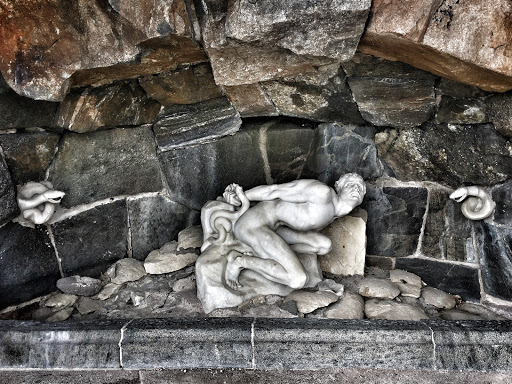
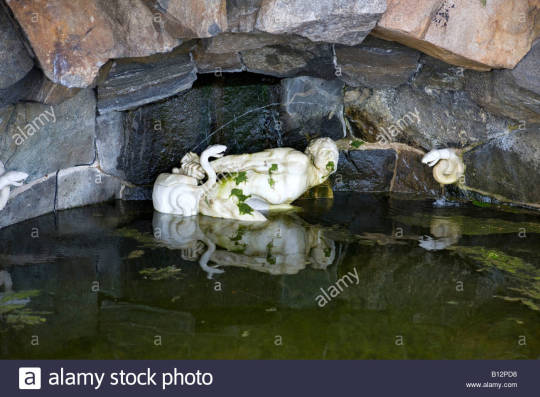

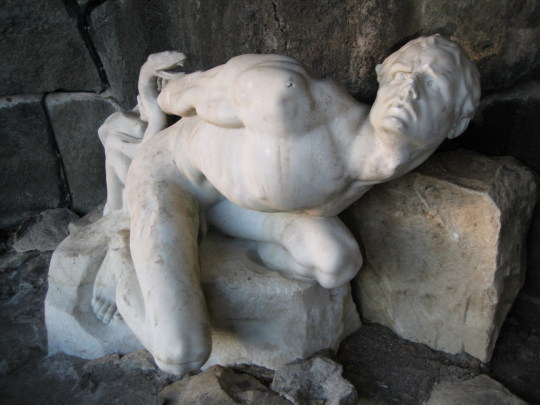
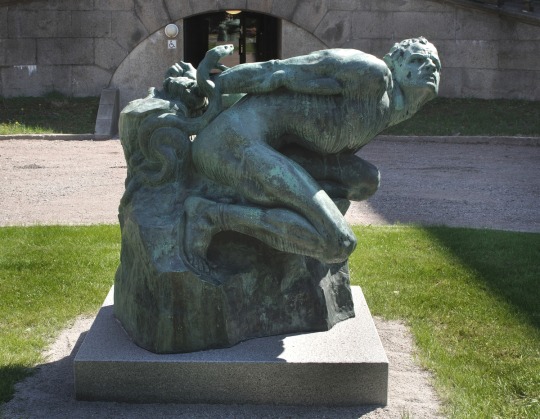
This is a statue of Loki in the Stockholm City Hall. I’ve found these pictures online but I can’t find any information on it (unless- do you speak Swedish? There may be some on their website.)
From these, maybe it was originally in that grotto and was moved to the gardens? Or are these two different statues of similar design?
One of the photo’s is captioned ‘1923′ but I can’t find the artist’s name.
When I saw it I was amazed; it was completely new to me. An old image of Loki that I’d never come across.
I find it very moving and I’d love to learn more about it. Does anyone out there have any ideas on this?
@theowlandfox @ididntknowhewasginger @hedendom @raven-maned-lokean @thoughtfulnightmaredestiny @latinalokean @drachenkinder@lokeanwelcomingcommittee @emsawitch @firehazard69
144 notes
·
View notes
Text

Whispers Of Yggdrasil
Robin Hoods Bay, England (5/2/21)
#asatru#forn sed#forn sidr#nordisk sed#åsatro#forn siðr#ásatrú#yggdrasil#norse myth#norse#norse paganism#norse mythology#mine#my picture#photography#unedited#hedendom#heathen#pagan#norse heathen#whitby#robin hoods bay#yorkshire
354 notes
·
View notes
Text
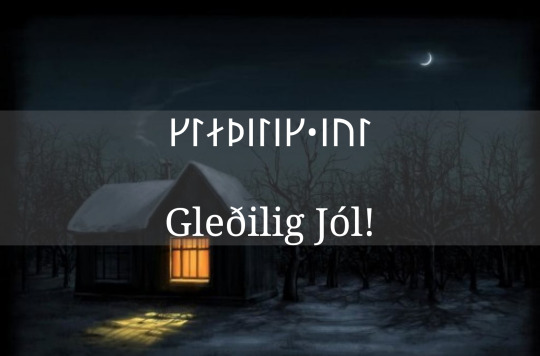
🔥To those starting Yule celebrations tonight or tomorrow, gleðilig jól!🔥
I tend to celebrate personally starting at this time and then with my living history group in mid-January going by the Old Norse time reckoning (around the full moon after the first new moon following the solstice). Having two rounds of Yule isn't the worst thing. 😉
28 notes
·
View notes
Note
I just realised that part of my reply did not exactly make sense. Vesen is a general word for otherworldly beings but vetter are specifically nordisk vesen. So vetter are specifically Nordic where vesen is just any otherworldly creatures and includes many non-Nordic folk beliefs and legends. A good example would be to compare pixies (from the UK) to alver (Nordic). So regarding the practices of folk belief (as I say, folketro) in Scandinavia, that is why is suggested vetter rather than vesen.
Aha, that makes sense. I think that in Icelandic vættur could be used regardless of what type of being it is or its origin. Good to know, and interesting how that developed. Thanks for the update!
7 notes
·
View notes
Photo
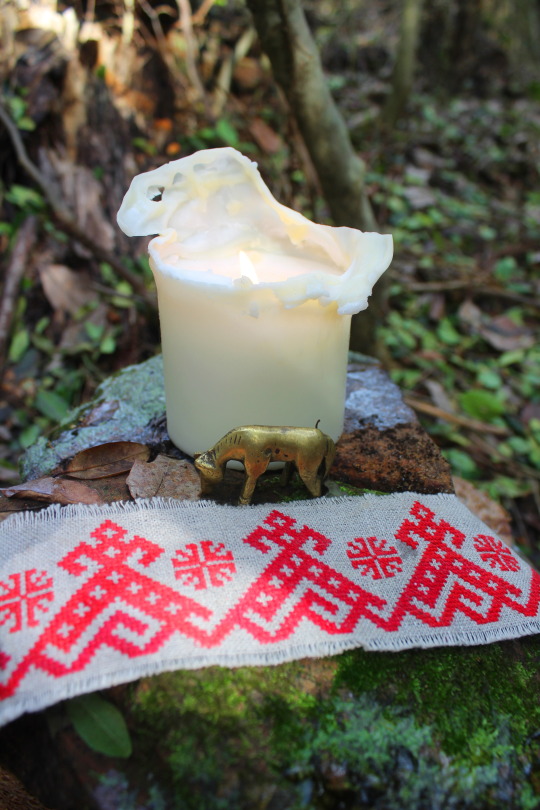

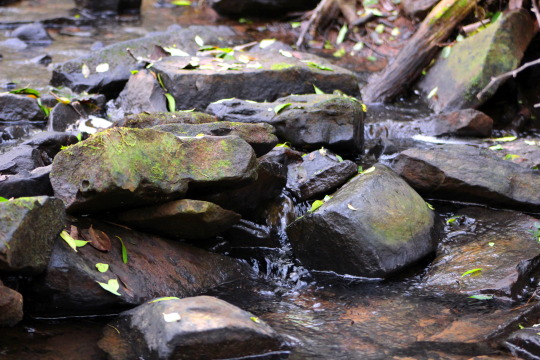

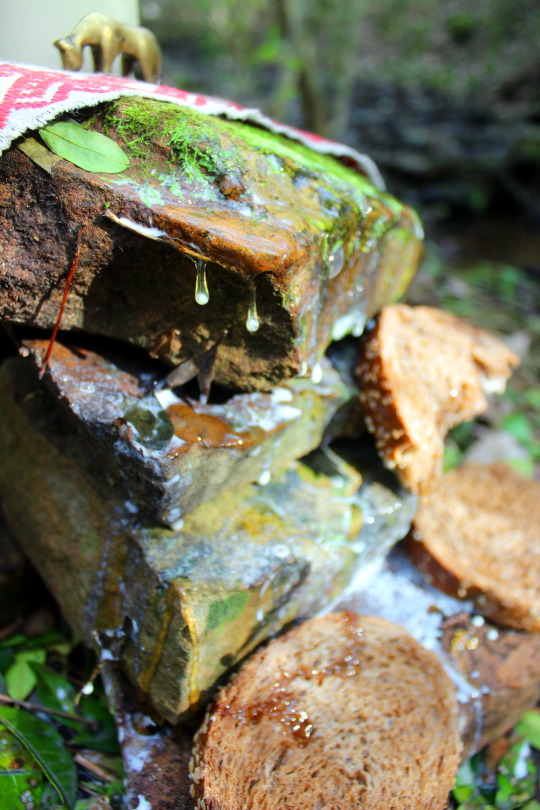
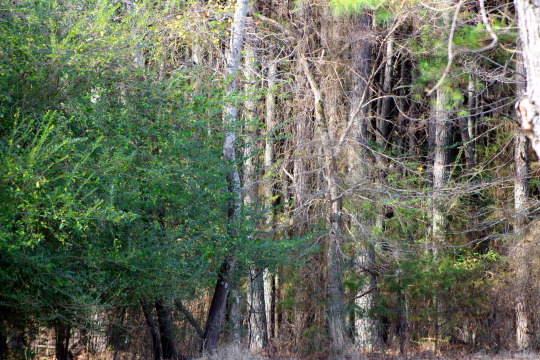
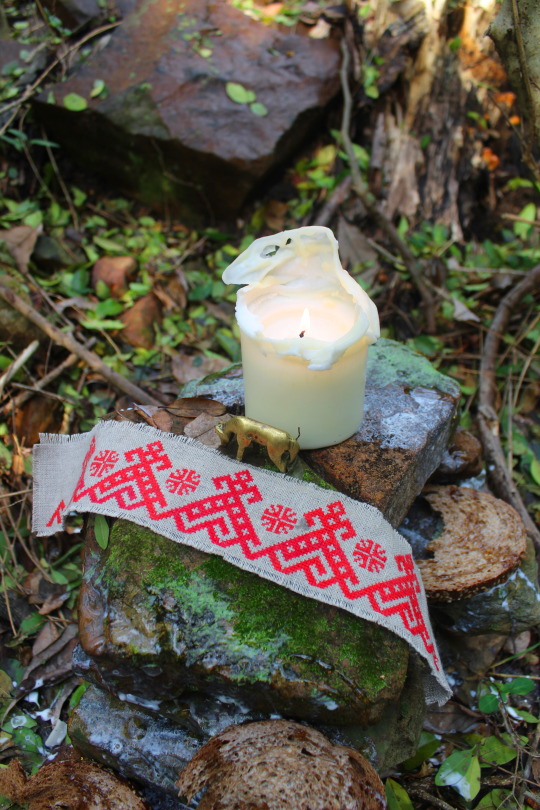

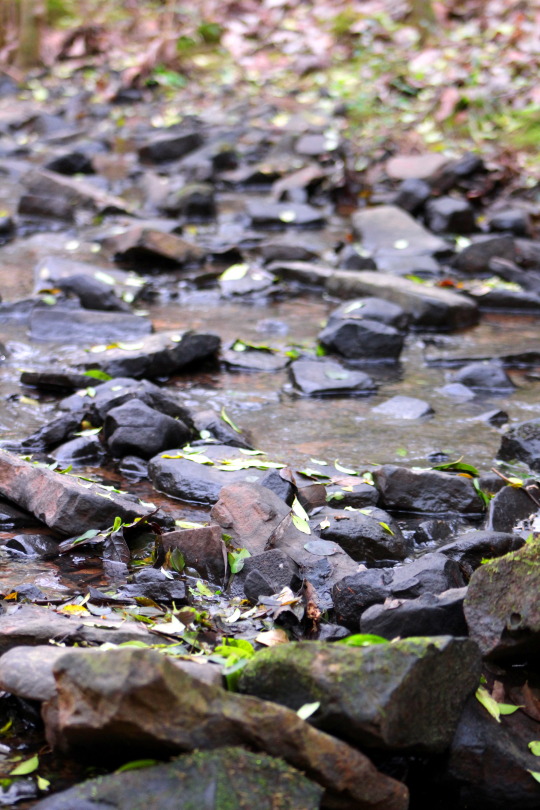

I went into the woods today and built a hearg by the creek behind the house in honor of Mōdraniht. The embroidery is an old goddess pattern and the horse represents Hofvarpnir (Hoof-Flourisher), Gna’s horse with which she brings messages and hopefully prayers to Frigg. I left offerings of bread, milk, and honey.
____________________
Wikipedia:
Mōdraniht or Modranicht (Old English "Night of the Mothers" or "Mothers' Night") was an event held at what is now Christmas Eve by the Anglo-Saxon Pagans. The event is attested by the medieval English historian Bede in his 8th-century Latin work De temporum ratione. It has been suggested that sacrifices may have occurred during this event. Scholars have proposed connections between the Anglo-Saxon Mōdraniht and events attested among other Germanic peoples (specifically those involving the dísir, collective female ancestral beings, and Yule) and the Germanic Matres and Matronae, female beings attested by way of altar and votive inscriptions, nearly always appearing in trios.
__________________________
Quote:
Horg
“þeir er hǫrg ok hof hátimbroðo”
“Shrines and temples they timbered high”
- Völuspá
A horg (Old Norse “hǫrgr”) is a sacrificial site or a form of altar in pre-Christian times in the Nordic countries and which roughly refers to a "stone pile".
In the poem Hyndluljóð, the goddess Frøya (Freyja) speaks favorably of Ottar (Óttar) for having worshiped her so faithfully by using a horg. Frøya details that the horg is constructed of a heap of stones and that Ottar often reddened these stones with sacrificial blood in dedication to her. Snorre Sturlason states that the horg is used in the veneration of the Åsynjene (female gods).
In the poem Vafþrúðnismál, it is also stated that many a horg and hov were dedicated to Njord (Njörðr).
A horg is considered different to a hov (from the Old Norse hof), commonly called a “temple”. A rough simplification is that horg were for outdoor rituals and hov for indoors worship.
Many modern day heathens within Scandinavia continue to use a stone set as a focal point for rituals conducted outdoors to this day.
Source:
hedendom
87 notes
·
View notes